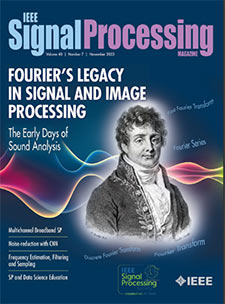- Our Story
- Publications & Resources
- Publications & Resources
- Publications
- IEEE Signal Processing Magazine
- IEEE Journal of Selected Topics in Signal Processing
- IEEE Signal Processing Letters
- IEEE/ACM Transactions on Audio Speech and Language Processing
- IEEE Transactions on Computational Imaging
- IEEE Transactions on Image Processing
- IEEE Transactions on Information Forensics and Security
- IEEE Transactions on Multimedia
- IEEE Transactions on Signal and Information Processing over Networks
- IEEE Transactions on Signal Processing
- IEEE TCI
- IEEE TSIPN
- Data & Challenges
- Submit Manuscript
- Guidelines
- Information for Authors
- Special Issue Deadlines
- Overview Articles
- Top Accessed Articles
- SPS Newsletter
- SigPort
- SPS Resource Center
- Publications Feedback
- Publications FAQ
- Blog
- News
- Dataset Papers
- Conferences & Events
- Community & Involvement
- Professional Development
- For Volunteers
- Information for Authors-OJSP
-
Home
Conferences Events IEEE JSTSP Article IEEE Signal Processing Magazine IEEE TIFS Article IEEE TMM Article IEEE TSP Article Jobs in Signal Processing Lectures Machine Learning Seasonal Schools Signal Processing News SPM Article SPS Distinguished Lectures SPS Newsletter Article SPS Webinar SPS Webinars SPS Webinar Series Webinar webinars
-
Our Story
What is Signal Processing?

The technology we use, and even rely on, in our everyday lives –computers, radios, video, cell phones – is enabled by signal processing. Learn More » -
Publications & Resources
-
SPS Resources
- Signal Processing Magazine The premier publication of the society.
- SPS Newsletter Monthly updates in Signal Processing
- SPS Resource Center Online library of tutorials, lectures, and presentations.
- SigPort Online repository for reports, papers, and more.
- SPS Feed The latest news, events, and more from the world of Signal Processing.
-
SPS Resources
-
Conferences & Events
-
Community & Involvement
-
Membership
- Join SPS The IEEE Signal Processing Magazine, Conference, Discounts, Awards, Collaborations, and more!
- Chapter Locator Find your local chapter and connect with fellow industry professionals, academics and students
- Women in Signal Processing Networking and engagement opportunities for women across signal processing disciplines
- Students Scholarships, conference discounts, travel grants, SP Cup, VIP Cup, 5-MICC
- Young Professionals Career development opportunities, networking
- Get Involved
-
Technical Committees
- Applied Signal Processing Systems
- Audio and Acoustic Signal Processing
- Bio Imaging and Signal Processing
- Computational Imaging
- Image Video and Multidimensional Signal Processing
- Information Forensics and Security
- Machine Learning for Signal Processing
- Multimedia Signal Processing
- Sensor Array and Multichannel
- Signal Processing for Communication and Networking
- Signal Processing Theory and Methods
- Speech and Language Processing
- Technical Working Groups
- More TC Resources
-
Membership
-
Professional Development
-
Professional Development
- Mentoring Experiences for Underrepresented Young Researchers (ME-UYR)
- Micro Mentoring Experience Program (MiME)
- Distinguished Lecturer Program
- Distinguished Lecturers
- Distinguished Lecturer Nominations
- Past Lecturers
- Distinguished Industry Speaker Program
- Distinguished Industry Speakers
- Distinguished Industry Speaker Nominations
- Industry Resources
- IEEE Training Materials
- Jobs in Signal Processing: IEEE Job Site
-
Career Resources
- SPS Education Program Educational content in signal processing and related fields.
- Distinguished Lecturer Program Chapters have access to educators and authors in the fields of Signal Processing
- PROGRESS Initiative Promoting diversity in the field of signal processing.
- Job Opportunities Signal Processing and Technical Committee specific job opportunities
- Job Submission Form Employers may submit opportunities in the area of Signal Processing.
-
Professional Development
-
For Volunteers
-
For Board & Committee Members
- Board Agenda/Minutes* Agendas, minutes and supporting documentation for Board and Committee Members
- SPS Directory* Directory of volunteers, society and division directory for Board and Committee Members.
- Membership Development Reports* Insight into the Society’s month-over-month and year-over-year growths and declines for Board and Committee Members
-
For Board & Committee Members
Popular Pages
Today's:
- Submit a Manuscript
- Information for Authors
- (ICASSP 2024) 2024 IEEE International Conference on Acoustics, Speech and Signal Processing
- Signal Processing Cup
- IEEE Transactions on Multimedia
- Membership
- IEEE/ACM Transactions on Audio Speech and Language Processing
- IEEE Transactions on Image Processing
- (ICASSP 2025) 2025 IEEE International Conference on Acoustics, Speech and Signal Processing
- (MLSP 2024) 2024 IEEE International Workshop on Machine Learning for Signal Processing
- (SLT 2024) 2024 IEEE Spoken Language Technology Workshop
- Award Recipients
- IEEE Signal Processing Letters
- IEEE Transactions on Information Forensics and Security
- Signal Processing 101
All time:
- Information for Authors
- Submit a Manuscript
- IEEE Transactions on Image Processing
- 404 Page
- IEEE/ACM Transactions on Audio Speech and Language Processing
- IEEE Transactions on Information Forensics and Security
- IEEE Transactions on Multimedia
- IEEE Signal Processing Letters
- IEEE Transactions on Signal Processing
- Conferences & Events
- IEEE Journal of Selected Topics in Signal Processing
- Information for Authors-SPL
- Conference Call for Papers
- Signal Processing 101
- IEEE Signal Processing Magazine
Last viewed:
- Membership
- (ICASSP 2024) 2024 IEEE International Conference on Acoustics, Speech and Signal Processing
- End-to-End Instance-Level Human Parsing by Segmenting Persons
- IEEE Transactions on Multimedia
- Governance Documents
- IEEE Transactions on Image Processing
- The Neural-SRP Method for Universal Robust Multi-Source Tracking
- SPS Scholarship Program
- About Transactions on Information Forensics and Security
- How MRIs are Changing How Society Looks at your Brain
- (ICIP 2025) 2025 IEEE International Conference on Image Processing
- Editorial Board
- Author Instructions For OJSP Reproducibility Review
- Submit a Manuscript
- IEEE Signal Processing Cup 2022
What Should We Learn from... Bio-Inspired Systems (I)
You are here
Newsletter Menu
Newsletter Categories
Top Reasons to Join SPS Today!
1. IEEE Signal Processing Magazine
2. Signal Processing Digital Library*
3. Inside Signal Processing Newsletter
4. SPS Resource Center
5. Career advancement & recognition
6. Discounts on conferences and publications
7. Professional networking
8. Communities for students, young professionals, and women
9. Volunteer opportunities
10. Coming soon! PDH/CEU credits
Click here to learn more.
News and Resources for Members of the IEEE Signal Processing Society
What Should We Learn from... Bio-Inspired Systems (I)
Bio-inspired systems can be traced back to the invention of radar systems. They are getting even more attention in recent years with topics such as the internet-of-things, intelligence and cognition becoming more and more relevant. Actually, people never stop the pave of learning from nature, animals and human beings.
Acoustic signals used by dolphins are studied to develop sonar systems in marine applications[1]. Bats’ multi-frequency transmission systems afford us lessons to optimize the cognitive radar systems for echolocation, tracking and detection targets[2]. A tree-inspired patch antenna array is proposed to improved the antenna’s gain by selecting the phase of the source feeding each element[3]. On the other hand, visualization plays more and more important roles in signal processing systems especially at the stage of decision. As the image or even video can be regarded as the detection plane, vision system inspired techniques are growing rapidly. The advanced algorithm of image or video processing with intelligent characteristics generally oriented from mammals or human being’s vision systems. The question is What are we looking for when viewing a visual scene?
Recent studies suggest that the answer to this question could be revealed via statistical analysis of human eye fixations. One possible answer named super Gaussian component was investigated in recent published paper “Towards Statistical Modeling of Saccadic Eye-movement and Visual Saliency”[4].
In this paper, the authors present a unified statistical framework for modeling both saccadic eye movements and visual saliency. By analyzing the statistical properties of human eye fixations on natural images, they found that human attention is sparsely distributed and usually deployed to locations with abundant structural information. Based on such observations, the authors propose a novel strategy to model saccadic behavior and visual saliency jointly based on Super Gaussian Component (SGC) analysis. The proposed model sequentially obtains super Gaussian components using iterative projection pursuit, and generates eye-movements by selecting the location with maximum SGC response. Besides human saccadic behavior simulation, the paper also demonstrated the superior effectiveness and robustness of the SGC model over state-of-the-arts by carrying out dense experiments on synthetic patterns and human eye fixation benchmarks.
Multiple key issues in saliency modeling research, such as individual differences, the effects of scale and blur, are also explored in this work. In model adaptively experiment, similar image-level performances among the tested models have been observed, and the degeneration caused by inter-viewer inconsistency was also discovered. The experiments on the effects of scale show that the multi-scale SGP scheme outputs overall better results, yet it still cannot beat the best single scale scheme in 65% of the cases, because the salient patterns in these cases are mostly gathered in a certain scale. Experiments on the effects of feature dimensions show that increasing the number of features might not always improve the model's overall performance and using a complete feature representation is usually not the optimal solution.
Different from previous works that mostly aim to reproduce the exact mechanisms of visual perception, inspirations are drawn from the statistical characteristics of real-world human behavior. Based on extensive qualitative and quantitative experimental results, the paper shows promising potentials of statistical approaches for both human behavior research and signal processing applications.
References:
[1] Y. Pailhas C. Capus K. Brown. Y. Pailhas C. Capus K. Brown. Dolphin-inspired sonar system and its performance. IET Radar Sonar Navig., 2012, 6(8), pp. 753–763 753
[2] Simon Haykin. Cognitive Radar: A way of the future. IEEE Signal Processing Magazine. 2006, 23(1) , pp. 30-40
[3]Karl F. Warnick. A Bio-Inspired Patch Antenna Array Using Fibonacci Sequences in Trees. IEEE Antennas and Propagation Magazine, 2013, 55(5), pp. 192-201
[4] Xiaoshuai Sun, Hongxun Yao, Rongrong Ji, Xian-Ming Liu. Towards Statistical Modeling of Saccadic Eye-movement and Visual Saliency. IEEE Transactions on Image Processing. 2014, 23(1), pp. 4649-4662.
Open Calls
Research Opportunities
Conference News
Society News
- Member in the Spotlight: Neil Wachowski
- IEEE SPS 2014 Members-at-Large and Directors-at-Large Election Results
- IEEE Dues Change for e-Membership
- Call for Nominations: Fellow Reference Committee
- Call for Nominations: IEEE Technical Field Awards
- Call for Nominations: Chapter of the Year
- Watch the 2014 IEEE Honors Ceremony on IEEE.tv
- Call for Nominations: N&A Committee and Awards Boards
- IEEE Annual Election: Last chance to Vote: Deadline 1 October
Initiatives & Trends
Chapter & DL News
PhD Theses
Education & Resources
Publications News
New Books
SPS on Twitter
- DEADLINE EXTENDED: The 2023 IEEE International Workshop on Machine Learning for Signal Processing is now accepting… https://t.co/NLH2u19a3y
- ONE MONTH OUT! We are celebrating the inaugural SPS Day on 2 June, honoring the date the Society was established in… https://t.co/V6Z3wKGK1O
- The new SPS Scholarship Program welcomes applications from students interested in pursuing signal processing educat… https://t.co/0aYPMDSWDj
- CALL FOR PAPERS: The IEEE Journal of Selected Topics in Signal Processing is now seeking submissions for a Special… https://t.co/NPCGrSjQbh
- Test your knowledge of signal processing history with our April trivia! Our 75th anniversary celebration continues:… https://t.co/4xal7voFER
Home | Sitemap | Contact | Accessibility | Nondiscrimination Policy | IEEE Ethics Reporting | IEEE Privacy Policy | Terms | Feedback
© Copyright 2024 IEEE – All rights reserved. Use of this website signifies your agreement to the IEEE Terms and Conditions.
A not-for-profit organization, IEEE is the world's largest technical professional organization dedicated to advancing technology for the benefit of humanity.









